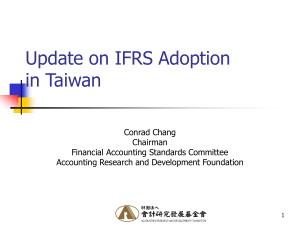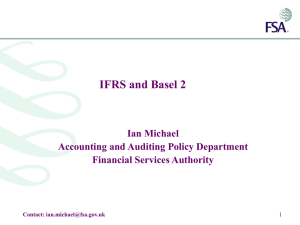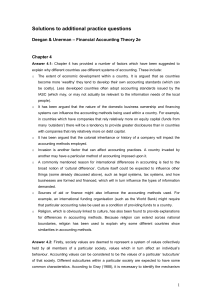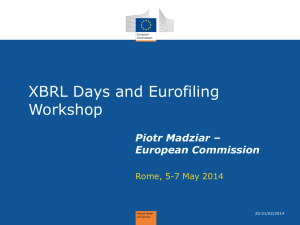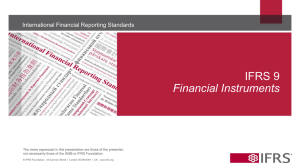Document
advertisement
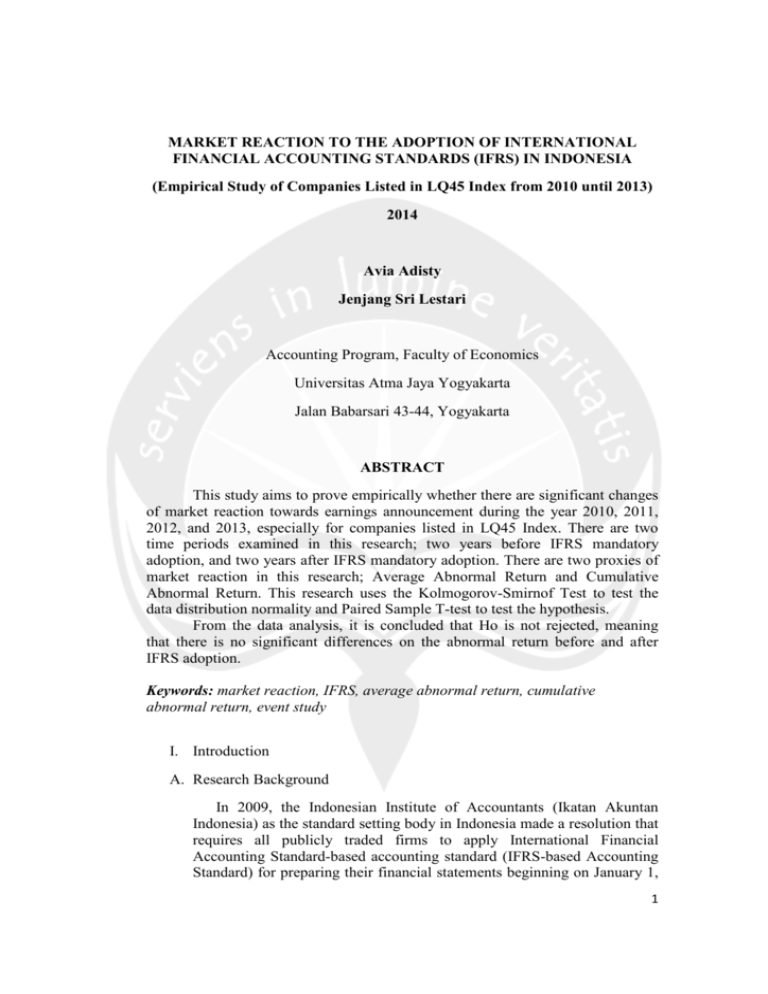
MARKET REACTION TO THE ADOPTION OF INTERNATIONAL FINANCIAL ACCOUNTING STANDARDS (IFRS) IN INDONESIA (Empirical Study of Companies Listed in LQ45 Index from 2010 until 2013) 2014 Avia Adisty Jenjang Sri Lestari Accounting Program, Faculty of Economics Universitas Atma Jaya Yogyakarta Jalan Babarsari 43-44, Yogyakarta ABSTRACT This study aims to prove empirically whether there are significant changes of market reaction towards earnings announcement during the year 2010, 2011, 2012, and 2013, especially for companies listed in LQ45 Index. There are two time periods examined in this research; two years before IFRS mandatory adoption, and two years after IFRS mandatory adoption. There are two proxies of market reaction in this research; Average Abnormal Return and Cumulative Abnormal Return. This research uses the Kolmogorov-Smirnof Test to test the data distribution normality and Paired Sample T-test to test the hypothesis. From the data analysis, it is concluded that Ho is not rejected, meaning that there is no significant differences on the abnormal return before and after IFRS adoption. Keywords: market reaction, IFRS, average abnormal return, cumulative abnormal return, event study I. Introduction A. Research Background In 2009, the Indonesian Institute of Accountants (Ikatan Akuntan Indonesia) as the standard setting body in Indonesia made a resolution that requires all publicly traded firms to apply International Financial Accounting Standard-based accounting standard (IFRS-based Accounting Standard) for preparing their financial statements beginning on January 1, 1 2012. IFRS is issued by the International Accounting Standard Board (IASB) which takes over the responsibilities of the International Accounting Standard Committee (IASC) since 2001. The mandatory adoption of IFRS is set as a result of Indonesian membership on G20 Forum. On a meeting of G20 Forum member held on November 15, 2008 it was agreed that the global IFRS adoption is aimed to strengthen transparency and accountability of the financial statements. Prihadi (2011) argue that by implementing IFRS, it will lead to least probability of doing unfair practices, because the methods allowed to be used is limited. A high quality financial statement will be able to provide both existing and potential investors information that mostly represents the actual condition of the firm. Thus, investors have a trustable reason to rely on the financial statements issued. Researches done in other countries have their measurements for a better reporting quality. Research done by Sun et al. (2011) uses the earnings quality for the measurement of foreign firms in United States. The research focused to the mandatory adoption of IFRS, resulted that small positive earnings decreased and earnings persistence increased. The same measurement used by Kabir et al. (2010) to examine the effect of IFRS adoption towards earnings quality of New Zealand firms, resulted a higher absolute discretionary accruals on the post-IFRS period, suggesting that IFRS increase earnings management. Landsman (2012) examined the effect of mandatory IFRS adoption towards information content of earnings announcement of 16 countries, measured through abnormal return volatility and abnormal trading volume. This research came up with result that abnormal return around earnings announcement increases after IFRS adoption. Previous researches examined the effects of adoption in countries outside Indonesia. Iatridis (2010) examined the presentation of financial statements in United Kingdom, Cormier et al. (2009) examined the effect of IFRS towards accounting practices in French, Morais & Curto (2008) in Portugal; Jeanjean & Stolowy (2008) in Australia, France, and United Kingdom; Ball et al. (2003) in Hong Kong, Malaysia, Singapore, and Thailand examined the effect of IFRS towards properties of accounting numbers, Lantto & Sahlstrom (2009) examined the effect of IFRS to financial ratios in Finland, Daske & Gebhardt (2006) in Austria, Germany, and Switzerland; Amstrong et al. (2010) in Europe examined the effect of IFRS to market reaction, find that IFRS cause significant changes in accounting amounts, their properties and correlation coefficients with market price. However, the degree of IFRS effect will be vary on each country depends on several things such as the strength of law enforcements and also the difference between the previous local accounting standard used before IFRS and the IFRS itself. Scott (2000) in Hoesada (2008) states that in order to achieve a globally comparable financial report used between issuer and investor, and 2 to avoid asymmetric information as well as to prevent moral hazard, a high quality accounting standard is needed. The adoption of IFRS caused Indonesian Accounting Standard that used to be Ruled-based change, and becoming Principle-based. The Principle-based nature of IFRS encourages firms to report accounting information that better reflects the economic substance over form and therefore promotes greater transparency (Maines et al. 2003 in Chua et al. 2012). Thus, it is logical to argue that there will be differences exist in the financial reporting quality resulted by IFRS-based Accounting Standard and by the previous accounting standard used. In this research, the difference is concerned to the financial reporting quality which in specific is the effect of mandatory IFRS adoption towards market reaction. B. Problem Statement It is claimed that by adopting IFRS, quality of financial statement is increased because IFRS requires fair value and more disclosure. If the degree of fair value and disclosure required in the financial statements is higher than the previous standard, it is expected that more investors will use financial statements as their information in making investment decisions. Therefore, value relevance becomes stronger. When information has greater value relevance, market is expected to be reacted. Referring to these changes of the degree of value relevance, fair value, and disclosure used, and researches done unto it, this research tries to examine whether changes in accounting standard will give impact to the usefulness of publicly available information, in specific is the market reaction changes before and after IFRS adoption. Thus, the research question is: Is the market reaction to the earnings announcement significantly different before and after IFRS adoption? C. Research Objective The objective of this research is to answer the question presented in problem statement. The answer will include information about mandatory International Financial Reporting Standard (IFRS) adoption that affect market reaction of listed companies in Indonesia from 2010-2013. II. Literature Review A. Theoretical Background The International Financial Accounting Standard (IFRS) is a globally-accepted accounting standard issued by the International Accounting Standard Board (IASB). IASB is organized under an independent foundation named the IFRS foundation. The foundation is a not-for-profit corporation which was created under the laws of the State of 3 Delaware, United States of America on March 2001. Starting on 2001, the IASB replaced the International Accounting Standards Committee (IASC) which was formed in 1973. Until March 31 2010, the IFRS Interpretations Committee was named the International Financial Reporting Interpretations Committee (IFRIC). IFRIC replaced the Standards Interpretations Committee (SIC) of the IASC with effect from 1 April 2001. The SIC was part of the original IASC structure formed in 1973 (Deloitte, 2014). The IASB engages closely with stakeholders around the world, including investors, analysts, regulators, business leaders, accounting standard-setters and the accountancy profession. Its members (currently 16 full-time members) are responsible for the development and publication of IFRSs, including the IFRS for SMEs and for approving Interpretations of IFRSs as developed by the IFRS Interpretations Committee (IFRS, 2014). The IASB develops its standard by conducting an extensive due process, which is founded on the principles of transparency, full and fair consultation, and accountability (IFRS, 2014). The IFRS are now used in more than 100 countries, including three quarters of the G20 and all the Member States of the European Union (IFRS, 2014). Consistent with the long-term objective of IASB, IFRS purport to be a set of high-quality accounting rules that would ideally be applied consistently by public companies globally to ensure that they are acceptable by the capital markets around the world (IASB 2009 in Chua et al. 2012). While there is no consensus as to what constitutes high-quality accounting standards, IFRS are perceived to be high quality because they represent a collection of the world’s best accounting practices and are purported to be more capital oriented than many domestic accounting standards (Ding et al. 2007 in Chua et al. 2012). The goal of IFRS is to provide a global framework for how public companies prepare and disclose their financial statements. IFRS provides general guidance for the preparation of financial statements, rather than setting rules for industryspecific reporting. At December 23, 2008 the Indonesian Institute of Accountant stated that the Indonesian Accounting Standard will be converged to IFRS as of 2012. There are two adopting strategies for IFRS convergence; big bang strategy and gradual strategy. Big bang strategy (also known as shock therapy or cold turkey) is a simultaneous and quick implementation of all (transition) reforms. In other words, the big bang strategy is fully adopting IFRS without going through some phases. This strategy usually been chosen by advanced countries such as Australia. The adoption process by gradual strategy on the other hand, is done through some phases of adoption. The objective of general purpose financial reporting is to provide financial information about the reporting entity that is useful to existing and potential investors, lenders, and other creditors in making decisions about providing resources to the entity. Those decisions involve buying, 4 selling, or holding equity and debt instruments and providing or setting loans and other forms of credit (SFAC No.8 chapter 1: OB2). Decisions by existing and potential investor about buying, selling, or holding equity and debt instruments depend on the returns that they expect from an investment in those instruments; for example, dividends, principal and interest payments, or market price increases (SFAC No.8 chapter 1: OB3). B. Hypothesis Development The idea of this research is if the IFRS adoption in Indonesia increases the quality of financial reporting, the market will react positively towards the earnings announcement because increase in financial report quality means that information asymmetry decrease, which means that financial information transparency increase. When the financial information transparency increases, the investment climate will be supported because that means that investing climate in Indonesia is comparable to global investment climate. Then, whenever there are changes in the demand of capital market, the return given to investors will also change, where in this research the average abnormal return and cumulative abnormal return is used as the measurement of the market reaction. The idea of arguing that increase in financial reporting quality means that the information asymmetry decrease is supported by the research of Platikanova and Nobes (2006) who was examining the effect of IFRS adoption in Europe and found that firms with higher earnings management have a lower information asymmetry component. This argument is also supported by research done by Naranjo et al. (2013) resulted that at the post-IFRS period, firms are more likely to raise external financing and firms increase their use of equity capital if they experience decrease in information asymmetry. Research done by Barth et al. (1999) found that there was a positive market reaction towards convergence in Europe. Investors reacted positively by purchasing firms’ stock, that triggered increase of the stock price and caused a positive abnormal return (Thoradewa, 2012). However, research by Ball et al. (2003) found that the IFRS adoption in firms in East Asia did not bring any changes in the financial reporting quality. This happen because some investors believe that the cost to implement IFRS is greater than the benefit achieved, thus investors react negatively to the market by selling the shares they own and caused a decrease in stock price of the firms, and cause a negative abnormal return. Based on these idea and previous research, hypothesis can be formulated as follows: Ha : There is significant difference of the market reaction to the earnings announcement measured by abnormal return before and after IFRS adoption. 5 III. Research Methodology Variable used in this research is abnormal return. Abnormal return happens during the announcement date. Abnormal return will move positive and negatively depends on the information content and investors’ perspective to see the information. Abnormal return is formulated through these steps. 1. Calculating Actual Return Actual Return is measured through deducting closing price of the t-period by closing price of the t-1 period, divided by closing price of the t-1 period. It is formulated as follows. (Jogiyanto, 2010: 580) Ri,t = Where: Ri,t : the actual return of the i-security at t Pi,t : closing price of the i-security at t Pi,t 2. -1 : closing price of the i-security at t-1 Calculating Expected Return using Market-Adjusted Model There are three ways that can be chosen to calculate expected return; Mean-Adjusted Model, Market Model, and MarketAdjusted Model. This research was done using MarketAdjusted Model because securities used in this research are included to the LQ45 Index. The LQ45 Index includes stocks of companies that are most actively traded in Indonesia, therefore market index is always available. When a market index is always available, estimation period is not needed in the calculation. Market-Adjusted Model states that the best estimator to estimate return of a security is the current market index return. By using this model, the estimation period is not used because the expected return of the security is equal to the market index return. Thus, the expected return was calculated by: (Jogiyanto, 2010:591) E[Ri,t] = Where: E[Ri,t] : expected return at t, measured by Market-Adjusted Model LQ45t : market index return at t LQ45t-1 : market index return at t-1. 3. Calculating Abnormal Return 6 Abnormal return is the difference between actual return and expected return. It is formulated as follows. (Jogiyanto, 2010:580) ARi,t = Ri,t - E[Ri,t] Where: ARi,t : abnormal return of the i-security at t-period Ri,t : actual return of i-security at t-period E[Ri,t] : expected return at t-period, measured by MarketAdjusted Model 4. Calculating Average Abnormal Return Calculating Average Abnormal Return is not done for each security, it is done by calculating all securities with crosssectional way for each of the day in window period. Calculating Average Abnormal Return for t-period is formulated as follows. (Jogiyanto, 2010:592) AARt = Where: AARt ARi,t : average abnormal return at t-period : abnormal return of the i-security at t-period : number of securities 5. Calculating Cumulative Abnormal Return Another proxy that was used in this research is the Cumulative Abnormal Return. Calculating Cumulative Abnormal Return is done by summing up the abnormal return from the previous day in the window period for each security. It is formulated as follows. (Jogiyanto, 2010:595) CARi,t = Where: CARi,t : cumulative abnormal return of the i-security at tperiod, accumulated from abnormal return of the isecurity beginning on the first day in the window period ARi,a : abnormal return of the i-security at day-a IV. Data Analysis A. Sampling Results Data of listed companies in LQ45 during 2010, 2011, 2012, and 2013 was taken from Indonesian Stock Exchange official website. Data for the financial statement announcement dates, daily stock prices, and stock market index during 2011, 2012, 2013, and 2014 were taken from Indonesian Stock Exchange electronic library and official website. There were 45 companies listed in LQ45 during the year 2010 until 2013. However, in order to get a consistent sample, this thesis needed companies 7 that are consistently listed in LQ45 during 2010 until 2013. This consistency is needed mainly because the purpose of this research is to examine whether there is any significant difference reflected by the average abnormal return and cumulative abnormal return before and after IFRS adoption. Therefore, the total sample used for the period before and period after IFRS adoption has to be the same due to fair comparison. B. Hypothesis Testing Table 1 Paired Sample Test for AAR Pair 1 µ1 - µ2 Mean -.00135385 Paired Differences 95% Confidence Interval of the Difference Std. Std. Error Deviation Mean Upper Lower .00673558 .00254581 -.00758322 .00487552 t -.532 df 6 Sig. (2-tailed) .614 Criteria of this research is Ho will be accepted if p > 0.05, or Ho will be rejected if p < 0.05. Based on the result from Paired-Sample Test in table 1, the Sig. (2-tailed) is 0.614. This means that Ho is accepted. When Ho is accepted, it means that there is no significant difference between abnormal return before and after IFRS adoption. Some researchers about market reaction also use Cumulative Abnormal Return as the proxy. This research is also done by examining the Cumulative Abnormal Return. Cumulative Abnormal Return is the summing up value of abnormal return from the previous days during the window period. Unlike Average Abnormal Return, Cumulative Abnormal Return is done for each of the security. Table 2 Paired Sample Test for CAR Paired Differences 95% Confidence Interval of the Difference Pair 1 µ1 - µ2 Mean .00357 Std. Std. Error Deviation Mean .04228 .00863 Upper -.01428 Lower .02142 t df .413 23 Based on Table 2. Paired Sample Test for Cumulative Abnormal Return, result shows by Sig. (2-tailed) is 0.683. This means that there is no significant difference of the market reaction to the earnings announcement measured by cumulative abnormal return before and after IFRS adoption. 8 Sig. (2tailed) .683 Thus, this research has a conclusion that both proxies (Average Abnormal Return and Cumulative Abnormal Return) shows that the market does not react significantly different to the earnings announcement before and after IFRS adoption. C. Discussion Result from the hypothesis testing both for Average Abnormal Return and Cumulative Abnormal Return shows that there is no significant difference of the market reaction to the earnings announcement measured by abnormal return before and after IFRS adoption. This means that for investors, the information content, standards, and rules applied that are used to prepare financial statements does not change that much before and after January 1, 2012. The reason why IFRS is not new for investors is because actually before 2012, the Indonesian Institute of Accountants (IAI) has been decided to adopt International Financial Accounting Standards (as it was known by ‘harmonization’ in 1994 and ‘adoption’ in current time). On 1994, the Indonesian Institute of Accountants made a decision to do a total revision of PSAK (Indonesian Accounting Principles or Prinsip Akuntansi Indonesia at that time) by adopting some of the PSAK to the international accounting standards. Basically, Indonesia has begun adopting IAS since 1994 with the issuance of Financial Accounting Standards (SAK) 1994 that was replacing Indonesian Accounting Principles (PAI) 1984 which was adopted from the US GAAP (statement by Indonesian Institute of Accountants on February 2009). As of January 1, 2007 there were 28 PSAKs developed by reference to IAS/IFRS, 20 PSAKs developed by reference to US GAAP Pronouncements, 8 PSAKs self-developed by IAI, and 1 PSAK (Shari’a Banking) developed by reference to accounting standard issued by AAOIFI and relevant local regulators. Thus, with the development of PSAK from 2007 until at present it is reasonable to argue that the mandatory adoption of IFRS dated January 1 2012 is not new for investors because international standards that is adopted since January 1 2012 is not fully different from the previous accounting standard, and therefore is not a new decision to be experienced. For example, PSAK No. 16 (2007) about Aset Tetap is adopting most of the IAS 16 (2003) about Property, Plant, and Equipment. And PSAK No. 16 (2011) that is adopting IAS 16 per January 1, 2009 is replacing PSAK No. 16 (2007). This situation makes it possible for investors not to react significantly to the earnings announcement prepared based on IFRS-based PSAK mandated on January 1, 2012. 9 V. Conclusions A. Conclusion The objective of this research is to see whether mandatory adoption of International Financial Accounting Standards (IFRS) significantly affect market reaction of listed companies in LQ45 index. From the data analysis presented in chapter IV, it is concluded that the Ho is accepted. This means that there is no significant difference of the market reaction to the earnings announcement before and after IFRS adoption measured by average abnormal return and cumulative abnormal return. B. Limitation The limitation of this research is this research uses only companies that are listed in LQ45 index from the year 2010 until 2013 that must consecutively be available in Indonesian Stock Exchange. C. Suggestion For the next researchers who are interested in examining the effect of IFRS, it is suggested to have longer observation period that will bring more samples. 10 REFERENCES AICPA. 2014. A Roadmap for Convergence between IFRS and US GAAP: Memorandum of Understanding between FASB and IASB. http://www.ifrs.com/updates/fasb/memorandum.html Amiram, Dan. (2012). Financial Information Globalization and Foreign Investment Decision. Journal of International Accounting Research. 11 (2) Amstrong, Christopher., Barth, M., Jagolinzer, Alan., and Riedl, Edward. (2009). Market Reaction to the Adoption of IFRS in Europe. Harvard Business School Finance Working Paper No. 09-032 Balkan Conference Operational Research. (2005). Barth, M., W. Landsman, and M. Lang. (2008). International Accounting Standards and Accounting Quality. Journal of International Accounting Research Beest, Ferdy van., et al. (2009). Quality of Financial Reporting: measuring qualitative characteristics. NiCE Working paper 09-108 Claudia, Ursula. (2014). Analisis Perbedaan Kualitas. Akuntansi Sebelum dan Sesudah Konvergensi IFRS. S1 Thesis, UAJY Cormier, D,. Demaria, S,. Lapointe-Antunes, P,. and Teller, R,. (2009). First Time Adoption of IFRS, Journal of International Accounting Research Daske, Holger., Hail, Luzi., Leuz, Christian., and Verdi, Rodrigo. (2011). Mandatory IFRS Adoption Around the World: Early Evidence on the Economic Consequences. Working Paper No. 12 Deliotte. 2014. Overview of the Structure of IFRS Foundation and IASB. http://www.iasplus.com/en/resources/ifrsf/overview Fajr, Ahmada. (2012). Kuliah Akuntansi Online, lecture 1: Perkembangan Standar Akuntansi di Indoensia, viewed on March 2014, http://www.kuliahakuntansi.16mb.com/perkembangan-standarakuntansi-di-indonesia-bag-1.html/ Financial Accounting Standard Board (2010).Conceptual Framework for Financial Reporting: Chapter 1, The Objective of General Purpose Financial Reporting, and Chapter 3, Qualitative Characteristic for Useful Financial Information, Norwalk, Connecticut Hartono, Jogiyanto. (2007). Metode Penelitian Bisnis: Salah Kaprahdan Pengalaman-pengalaman. BPFE UGM, Yogyakarta 11 Hartono, Jogiyanto. (2009). Teori Portofolio dan Analisis Investasi. BPFE UGM, Yogyakarta Iatridis, G. (2010). IFRS Adoption of Financial Stock Efficiency: The UK Case, International Research Journal of Financial and Economic IFRS. 2014. International Accounting Standard http://www.ifrs.org/About-us/IASB/Pages/Home.aspx Board. Ikatan Akuntan Indonesia. (2012). Standar Akuntansi Keuangan Indonesia. PT Salemba Empat, Jakarta Klein, Linda Schimd., O’Brien, Thomas J., and Peters, Stephen R., (2002). Debt vs. Equity and Asymmetric Information: A Review. The Financial Review Klimczack, Karol Marek. (2011). Market Reaction to the Mandatory IFRS Adoption: Evidence from Poland. Journal of International Accounting Research Landsman, Wayne R., Maydew, Edward L., Thornock, Jacob R. (2012). The Information Content of Annual Earnings Announcements and Mandatory Adoption of IFRS. Journal of Accounting & Economics (JAE), Forthcoming Lee, Edward., Walker, Martin., and Zeng, Colin. (2013). Does IFRS Convergence Affect Financial Reporting Quality in China?. Research Report 131 Mc-Graw Hill. (2010). The Efficient Market Hypothesis. Tenth Edition. Platikanova, Petya., and Nobes, Christopher. (2006). Was the Introduction of IFRS in Europe Value-Relevant?. Working Paper Series Sekaran, Uma. (2013). Research Method for Business. New York: John Wiley & Sons, inc. Simbolon, Harry Andrian. 2014. Business dan Accounting: Perkembangan Konverjensi PSAK ke IFRS. http://akuntansibisnis.wordpress.com/2011/01/06/perkembangankonvergensi-psak-ke-ifrs/ Thoradewa, Anthonius Ardi. (2012). Reaksi Pasar Modal Terhadap Penetapan Pernyataan Standar Akuntansi Keuangan Berbasis International Financial Accounting Standards di Indonesia. S1 Thesis, UAJY 12

